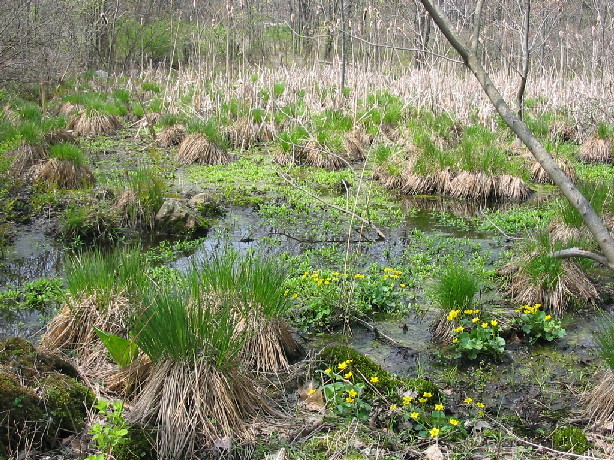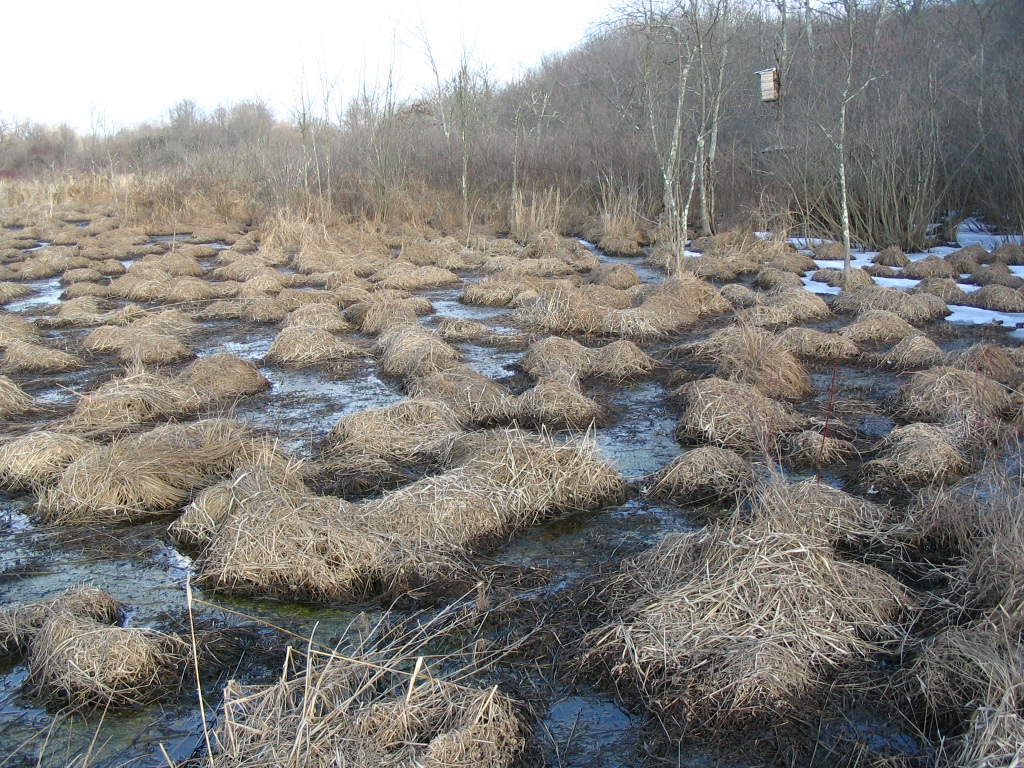Wetlands are vitally important to the existence of Bog Turtles. Bog Turtles are habitat specialists which means they cannot tolerate habitat conditions that are outside of their preference. Their primary habitat consists of spring fed wetlands with mucky soils and open, emergent vegetation. Secondary and/or seasonal habitat may consist of scrub-shrub and forested wetlands. The species utilizes wetlands for foraging, resting, basking, nesting, shelter, and over-wintering purposes. The loss of suitable wetland habitats to support Glyptemys [Clemmys] muhlenbergii has been a major factor in the decline of the species. Potential Bog Turtle habitat is recognized by the following three criteria (USFWS 2001, revised April 2006):


Suitable Hydrology
Bog Turtle wetlands are typically spring-fed with shallow surface water or saturated soils present year-round, although in summer the wet area(s) may be restricted to near spring head(s). Typically these wetlands are interspersed with dry and wet pockets. There is often subsurface flow. In addition, shallow rivulets (less than 10 cm deep) or pseudo-rivulets are often present.
Suitable Soils
Usually a bottom substrate of permanently saturated organic or mineral soils. These are often soft, mucky-like soils (this does not refer to a technical soil type); you will usually sink to your ankles (3-5 inches) or deeper in muck, although in degraded wetlands or summers of dry years this may be limited to areas near spring heads or drainage ditches. In some portions of the species’ range, the soft substrate consists of scattered pockets of peat instead of muck. According to Carter et al. (1999), Bog Turtles show a close association with mud and shallow water. This suggests that they use the soft substrate to meet specific biological requirements such as predator avoidance or thermoregulation.
Suitable Vegetation
Dominant vegetation within Bog Turtle wetlands consists of low grasses and sedges (an emergent wetland), often with a scrub-shrub wetland component. In Virginia, Carter et al. (1999) found that the median vegetation height at Bog Turtle locations was 55 cm, with a range of 20 – 107. Common emergent vegetation includes: tussock sedge (Carex stricta), soft rush (Juncus effusus), rice cut grass (Leersia oryzoides), sensitive fern (Onoclea sensibilis), tearthumbs (Polygonum spp.), jewelweeds (Impatiens spp.), arrowheads (Sagittaria spp.), skunk cabbage (Symplocarpus foetidus), Panic grass (Panicum spp.), other sedges (Carex spp.), spike rushes (Eleocharis spp.), grass-of-Parnassus (Parnassia glauca), shrubby cinquefoil (Potentilla fruticosa), sweet flag (Acorus calamus) and in disturbed sites, reed canary grass (Phalaris arundinacea). Common scrub-shrub species include alder (Alnus spp.), red maple (Acer rubrum), willow (Salix spp.), tamarack (Larix laricina) and in disturbed sites, multiflora rose (Rosa multiflora). Some forested wetland habitats are suitable given hydrology, soils, and/or historic land use. These forested wetlands include red maple, tamarack, and cedar swamps.
The USFWS also notes that one or more of the above criteria may be absent from portions of a wetland or wetland complex supporting Bog Turtles. Absence of one or more of above criteria does not preclude use of the habitat for foraging, shelter, and dispersal of Bog Turtles. Suitable hydrology and soils are the critical criteria (i.e., the primary determinants of potentially suitable habitat).
